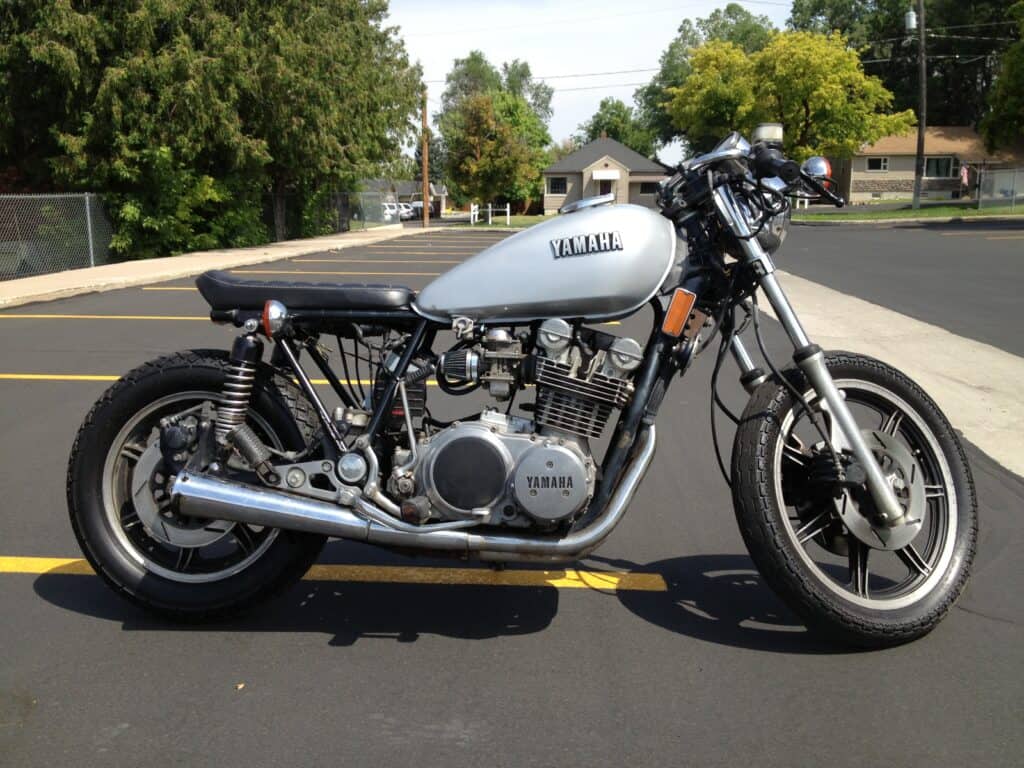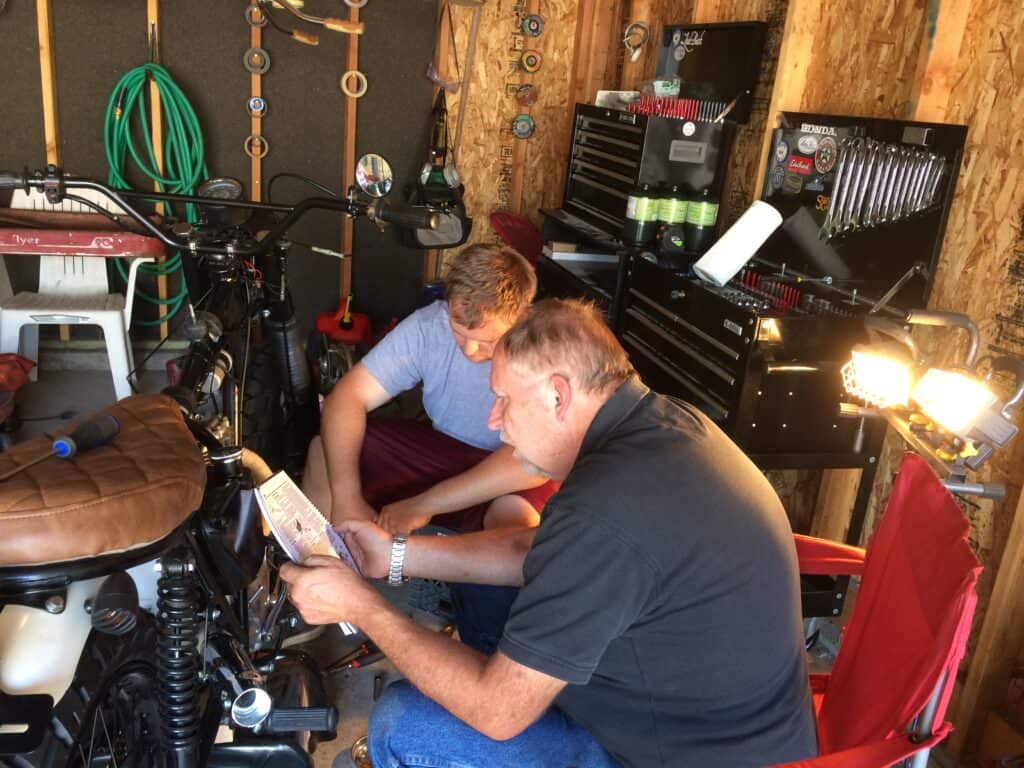
For a long time, I wanted to learn how to restore motorcycles. Before I got started though, I wondered if it was possible to get into such a hobby without any (literally zero) experience.
Through my research and many personal experiences, I can answer this question: do you need experience to restore a motorcycle? You do not need experience to restore a motorcycle. This is a skill that can be self taught if you have the determination, funds, and space to work with. Many people learn this skill on their own without needing official education.
Most people assume a motorcycle restoration is complicated, when in reality it’s a lot simpler than we realize. I learned this quickly with my first motorcycle restoration.
I did a lot of research and decided to take the plunge at restoring my first motorcycle. Now I have restored close to twenty motorcycles (again, with zero previous experience) and I have discovered some helpful tips that make a world of difference when starting a motorcycle restoration.
What You Should Know Before Restoring a Motorcycle

My first motorcycle restoration was a 1980 Yamaha XS850 (pictured above). I had absolutely no idea what I was doing. I was recovering from surgery and was out of work for the summer because of my injury. I was also a college student at the time and had some extra time with $500 to spend. So I dove into my first project.
I quickly learned that there are six main sections of a motorcycle: the fuel system, power delivery, exhaust, electrical, steering, and braking. Try to not take on too much all at once, in other words, focus on one section or system at a time. Once you tackle and restore one system, you’ll feel so proud of yourself and be motivated to move on to the next system.
Being mechanically inclined definitely helps with the process, but it is not necessary. Your motivation will be enough to get you through your project. One of the key points to remember is “don’t take anything apart that you can’t put back together.” Take TONS of pictures of how things bolt together, how pieces fit together, where gaskets are supposed to be, etc.
When you are taking small parts off, label them like crazy, even if you think you’ll remember where it goes. Place bolts in labeled plastic baggies, use tape flags on wires, etc. Do not skip this part! I once had a friend who decided to throw all of his bolts into a single bucket while he attempted to restore a motorcycle. When he was putting everything back together, he came to a dead end because he didn’t know which bolts and pieces went where.
Save any cosmetics for the very end. For example, the last thing you want is to have a nice and freshly painted motorcycle tank only to end up with a scratch from the wrench or screwdriver you had to use on the handle bars. Get all the dirty mechanical stuff out of the way so your cosmetic work displays brightly on your motorcycle. Click here to see my list of recommended upgrades for a motorcycle.
The Best Kind Of Motorcycle To Restore With Little To No Experience
Though experience is not required to restore a motorcycle, I still recommend an older and smaller bike to start out with such as a CB100 that is a four stroke or something similar to that size. That way you can get a little practice on something that isn’t worth as much. Click here to see my list of the best beginner motorcycles to restore.
Once you get a little more comfortable, you can sell your newly restored motorcycle, hopefully for a profit, and buy yourself something bigger that provides you a little bit more of a challenge. You’re okay initially buying something bigger if you’re comfortable with it, just understand that it is a higher and more expensive risk if you make a big mistake.
The best place to look for used motorcycles is online, specifically Facebook Marketplace and Craigslist. These are the places I found most of my motorcycle projects with relatively little problems from the seller. These platforms make it easy to contact the seller, know their location, and know how far you’ll need to go to get the motorcycle.
It’s also a good idea to look into any local websites or newspapers for anything that’s for sale. For example, Utah, Idaho, and Wyoming have a website called KSL which is where all the locals go to sell their stuff.
Is It Worth Learning How to Restore a Motorcycle?
The short answer? Yes! If you have the desire and the motivation, it is absolutely worth it. I could go on and on about pursuing your dreams and accomplishing that self fulfillment, but there’s actually additional value to this.
After I restored my first motorcycle, I knew I could restore more. As I mentioned earlier, I’ve restored almost twenty motorcycles and sold them for at least $2,000 profit each. Motorcycle restorations paid for a lot of my college education and my cost of living during that time. That is also how I paid for my wife’s engagement ring.
Pursuing this hobby also increases your technical skills. I ended up putting my motorcycle restorations on my resume; I was a little skeptical about at first, but it ended up well. I ultimately received many job interviews and several job offers in an unrelated field with a lot of comments from employers about my motorcycle restorations. Most of my job interviewers discussed the motorcycle projects I had completed.
In addition to increasing your technical skills, restoring a motorcycle also helps you understand more how a car works. Obviously, the functionality of a car is a lot more complicated than a motorcycle, but their principles are the same. You learn how a battery on a motorcycle works, you now have an idea of how a battery works on a car. You get a sense of how power delivery works on a motorcycle, you get a better sense of how it works on a car.
I have created an entire video series on restoring a motorcycle from start to finish. I turn a $200 motorcycle into a $5,000 motorcycle and created this with beginners in mind. Included are in depth videos with tips and tricks you won’t find anywhere else online as well as hard to tackle components such as wiring, body work, and carb rebuilds. Click here for more information if you’re interested in restoring and building the motorcycle of your dreams!
How Hard Is It to Restore A Motorcycle?

Restoring a motorcycle can be difficult. If you have no experience, you’ll certainly encounter a learning curve. However, if you’re determined, there are millions of resources out there to help you learn for free. Everything I learned about motorcycles and restoring them was from the internet and Youtube.
You will run into frustrations and you will come to halts. I can’t tell you how many times this happened to me. As frustrating as it was, I kept working and kept persevering and was able to find the answers I needed. You must be willing to think outside the box and be willing to ask for help
There will also be instances where you find a problem that you simply don’t have the resources to fix. Mounting tires, for example, is one of those fixes. I always get new tires for my motorcycle projects but I don’t have a tire mount hanging around my garage. Sometimes, it is worth it taking your motorcycle to a mechanic to fix specific problems.
The awesome thing about taking your motorcycle to a mechanic is that you get to learn about a specific problem that you’ll probably encounter in the future with another motorcycle. You’ll be able to identify the problem and fix it yourself because of what you learned from the mechanic. Click here to see a list I compiled of helpful tips for restoring a motorcycle.
If you’re thinking about purchasing a project motorcycle or already have a motorcycle to restore, give yourself the chance to learn about it and teach yourself how to fix it. It may take time, but don’t let that stop you from learning an incredible skill.
Related Questions
Which is cheaper, restoring an old motorcycle from scratch or buying a new one? Generally a newer motorcycle will cost you around $5,000 – $10,000 whereas an old motorcycle restoration will cost you between $1,500 – $2,500. Restoring a motorcycle does take time, but in the long run it is cheaper.
What are the first things I should do when restoring a motorcycle? Start with the simple things first such as the battery, carbs, gas, and spark plugs. It’s better to start with smaller things and work your way to bigger fixes. That way you don’t become overwhelmed from the very beginning.
